GLOBEx Project Management for i-Crop System Development Report
VerifiedAdded on 2023/06/05
|16
|2711
|90
Project
AI Summary
This project report details the project management plan for GLOBEx's i-Crop system, developed by Virtucon. It begins with an introduction to the project's objectives: replacing an error-prone manual system with a semi-automated, efficient platform for managing grain buyers and sellers. The report then delves into the Measurable Organizational Value (MOV), outlining strategic, social, financial, and operational aspects. Scope management is addressed, including resource lists, a scope management plan, and change management procedures. A Work Breakdown Structure (WBS) is presented, followed by project risk analysis, risk identification, and risk assessment. The quality plan outlines verification and validation activities. The report concludes with a closure checklist, project evaluation, and an annotated bibliography. The report covers various phases of the project including initiation, planning, execution, and closure, emphasizing key metrics, stakeholder needs, and potential risks. The report aims to provide a comprehensive overview of the project's lifecycle and successful implementation.
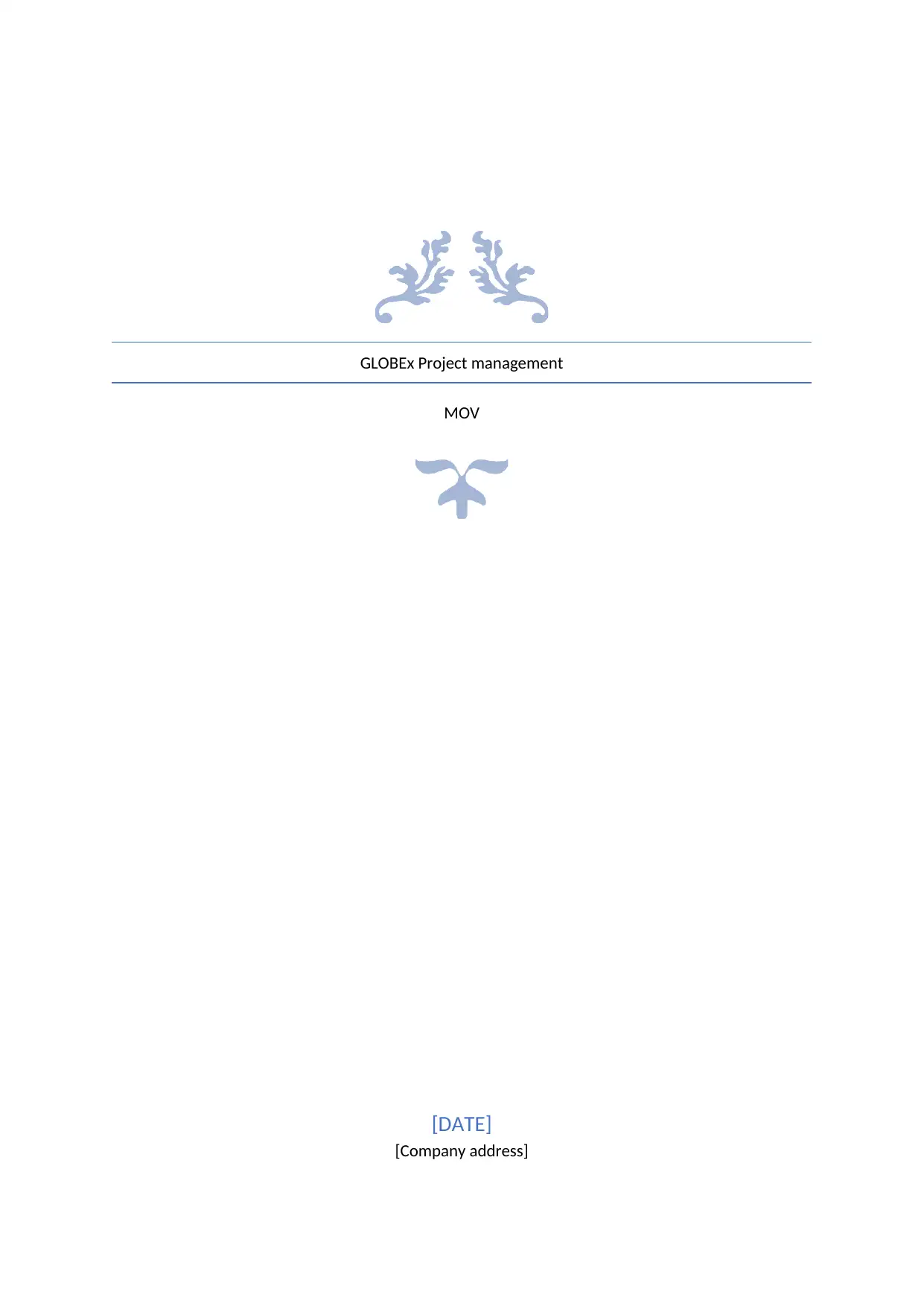
GLOBEx Project management
MOV
[DATE]
[Company address]
MOV
[DATE]
[Company address]
Paraphrase This Document
Need a fresh take? Get an instant paraphrase of this document with our AI Paraphraser
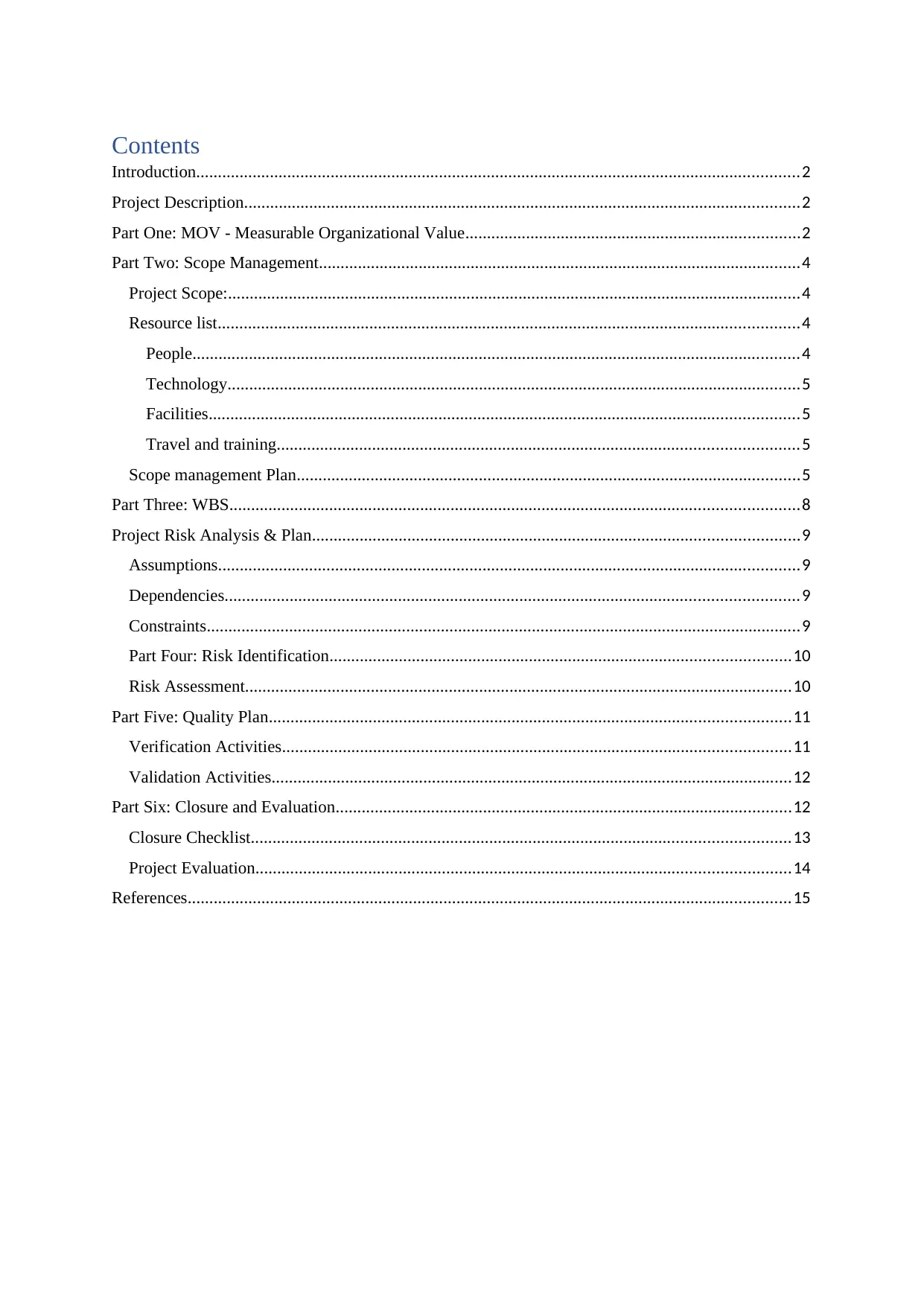
Contents
Introduction...........................................................................................................................................2
Project Description................................................................................................................................2
Part One: MOV - Measurable Organizational Value.............................................................................2
Part Two: Scope Management...............................................................................................................4
Project Scope:....................................................................................................................................4
Resource list......................................................................................................................................4
People............................................................................................................................................4
Technology....................................................................................................................................5
Facilities........................................................................................................................................5
Travel and training........................................................................................................................5
Scope management Plan....................................................................................................................5
Part Three: WBS...................................................................................................................................8
Project Risk Analysis & Plan................................................................................................................9
Assumptions......................................................................................................................................9
Dependencies....................................................................................................................................9
Constraints.........................................................................................................................................9
Part Four: Risk Identification..........................................................................................................10
Risk Assessment..............................................................................................................................10
Part Five: Quality Plan........................................................................................................................11
Verification Activities.....................................................................................................................11
Validation Activities........................................................................................................................12
Part Six: Closure and Evaluation.........................................................................................................12
Closure Checklist............................................................................................................................13
Project Evaluation...........................................................................................................................14
References...........................................................................................................................................15
Introduction...........................................................................................................................................2
Project Description................................................................................................................................2
Part One: MOV - Measurable Organizational Value.............................................................................2
Part Two: Scope Management...............................................................................................................4
Project Scope:....................................................................................................................................4
Resource list......................................................................................................................................4
People............................................................................................................................................4
Technology....................................................................................................................................5
Facilities........................................................................................................................................5
Travel and training........................................................................................................................5
Scope management Plan....................................................................................................................5
Part Three: WBS...................................................................................................................................8
Project Risk Analysis & Plan................................................................................................................9
Assumptions......................................................................................................................................9
Dependencies....................................................................................................................................9
Constraints.........................................................................................................................................9
Part Four: Risk Identification..........................................................................................................10
Risk Assessment..............................................................................................................................10
Part Five: Quality Plan........................................................................................................................11
Verification Activities.....................................................................................................................11
Validation Activities........................................................................................................................12
Part Six: Closure and Evaluation.........................................................................................................12
Closure Checklist............................................................................................................................13
Project Evaluation...........................................................................................................................14
References...........................................................................................................................................15
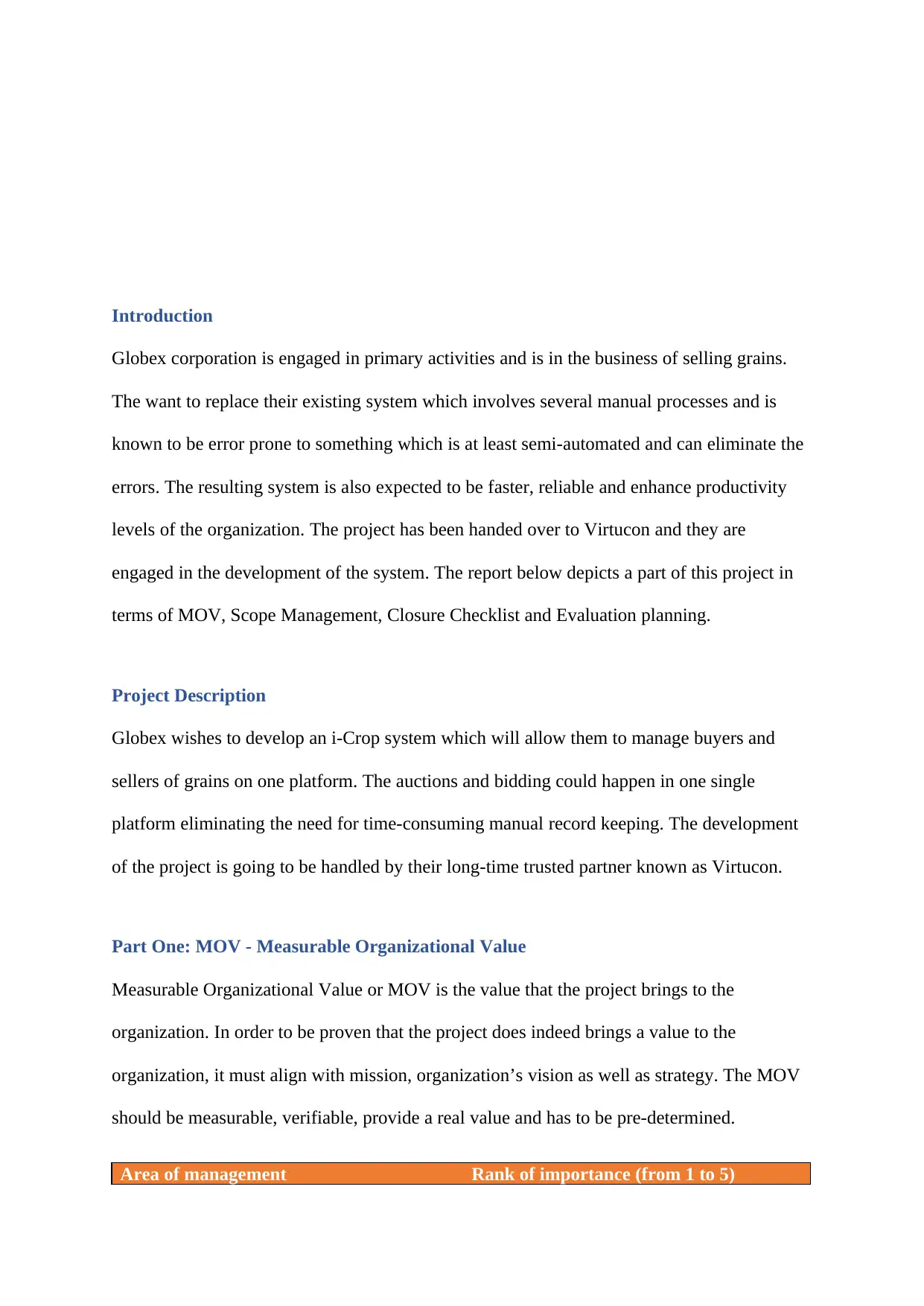
Introduction
Globex corporation is engaged in primary activities and is in the business of selling grains.
The want to replace their existing system which involves several manual processes and is
known to be error prone to something which is at least semi-automated and can eliminate the
errors. The resulting system is also expected to be faster, reliable and enhance productivity
levels of the organization. The project has been handed over to Virtucon and they are
engaged in the development of the system. The report below depicts a part of this project in
terms of MOV, Scope Management, Closure Checklist and Evaluation planning.
Project Description
Globex wishes to develop an i-Crop system which will allow them to manage buyers and
sellers of grains on one platform. The auctions and bidding could happen in one single
platform eliminating the need for time-consuming manual record keeping. The development
of the project is going to be handled by their long-time trusted partner known as Virtucon.
Part One: MOV - Measurable Organizational Value
Measurable Organizational Value or MOV is the value that the project brings to the
organization. In order to be proven that the project does indeed brings a value to the
organization, it must align with mission, organization’s vision as well as strategy. The MOV
should be measurable, verifiable, provide a real value and has to be pre-determined.
Area of management Rank of importance (from 1 to 5)
Globex corporation is engaged in primary activities and is in the business of selling grains.
The want to replace their existing system which involves several manual processes and is
known to be error prone to something which is at least semi-automated and can eliminate the
errors. The resulting system is also expected to be faster, reliable and enhance productivity
levels of the organization. The project has been handed over to Virtucon and they are
engaged in the development of the system. The report below depicts a part of this project in
terms of MOV, Scope Management, Closure Checklist and Evaluation planning.
Project Description
Globex wishes to develop an i-Crop system which will allow them to manage buyers and
sellers of grains on one platform. The auctions and bidding could happen in one single
platform eliminating the need for time-consuming manual record keeping. The development
of the project is going to be handled by their long-time trusted partner known as Virtucon.
Part One: MOV - Measurable Organizational Value
Measurable Organizational Value or MOV is the value that the project brings to the
organization. In order to be proven that the project does indeed brings a value to the
organization, it must align with mission, organization’s vision as well as strategy. The MOV
should be measurable, verifiable, provide a real value and has to be pre-determined.
Area of management Rank of importance (from 1 to 5)
⊘ This is a preview!⊘
Do you want full access?
Subscribe today to unlock all pages.

Trusted by 1+ million students worldwide
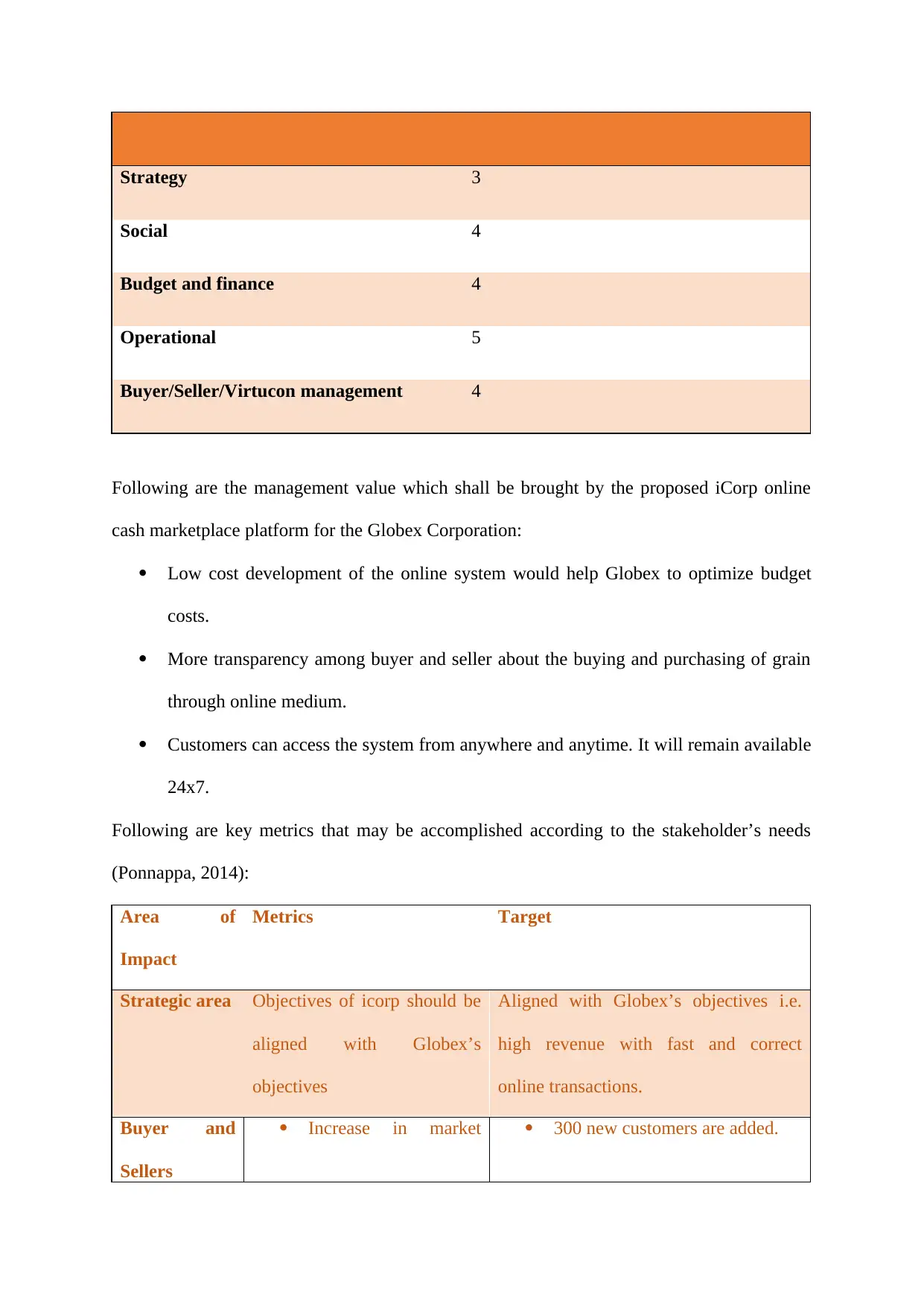
Strategy 3
Social 4
Budget and finance 4
Operational 5
Buyer/Seller/Virtucon management 4
Following are the management value which shall be brought by the proposed iCorp online
cash marketplace platform for the Globex Corporation:
Low cost development of the online system would help Globex to optimize budget
costs.
More transparency among buyer and seller about the buying and purchasing of grain
through online medium.
Customers can access the system from anywhere and anytime. It will remain available
24x7.
Following are key metrics that may be accomplished according to the stakeholder’s needs
(Ponnappa, 2014):
Area of
Impact
Metrics Target
Strategic area Objectives of icorp should be
aligned with Globex’s
objectives
Aligned with Globex’s objectives i.e.
high revenue with fast and correct
online transactions.
Buyer and
Sellers
Increase in market 300 new customers are added.
Social 4
Budget and finance 4
Operational 5
Buyer/Seller/Virtucon management 4
Following are the management value which shall be brought by the proposed iCorp online
cash marketplace platform for the Globex Corporation:
Low cost development of the online system would help Globex to optimize budget
costs.
More transparency among buyer and seller about the buying and purchasing of grain
through online medium.
Customers can access the system from anywhere and anytime. It will remain available
24x7.
Following are key metrics that may be accomplished according to the stakeholder’s needs
(Ponnappa, 2014):
Area of
Impact
Metrics Target
Strategic area Objectives of icorp should be
aligned with Globex’s
objectives
Aligned with Globex’s objectives i.e.
high revenue with fast and correct
online transactions.
Buyer and
Sellers
Increase in market 300 new customers are added.
Paraphrase This Document
Need a fresh take? Get an instant paraphrase of this document with our AI Paraphraser
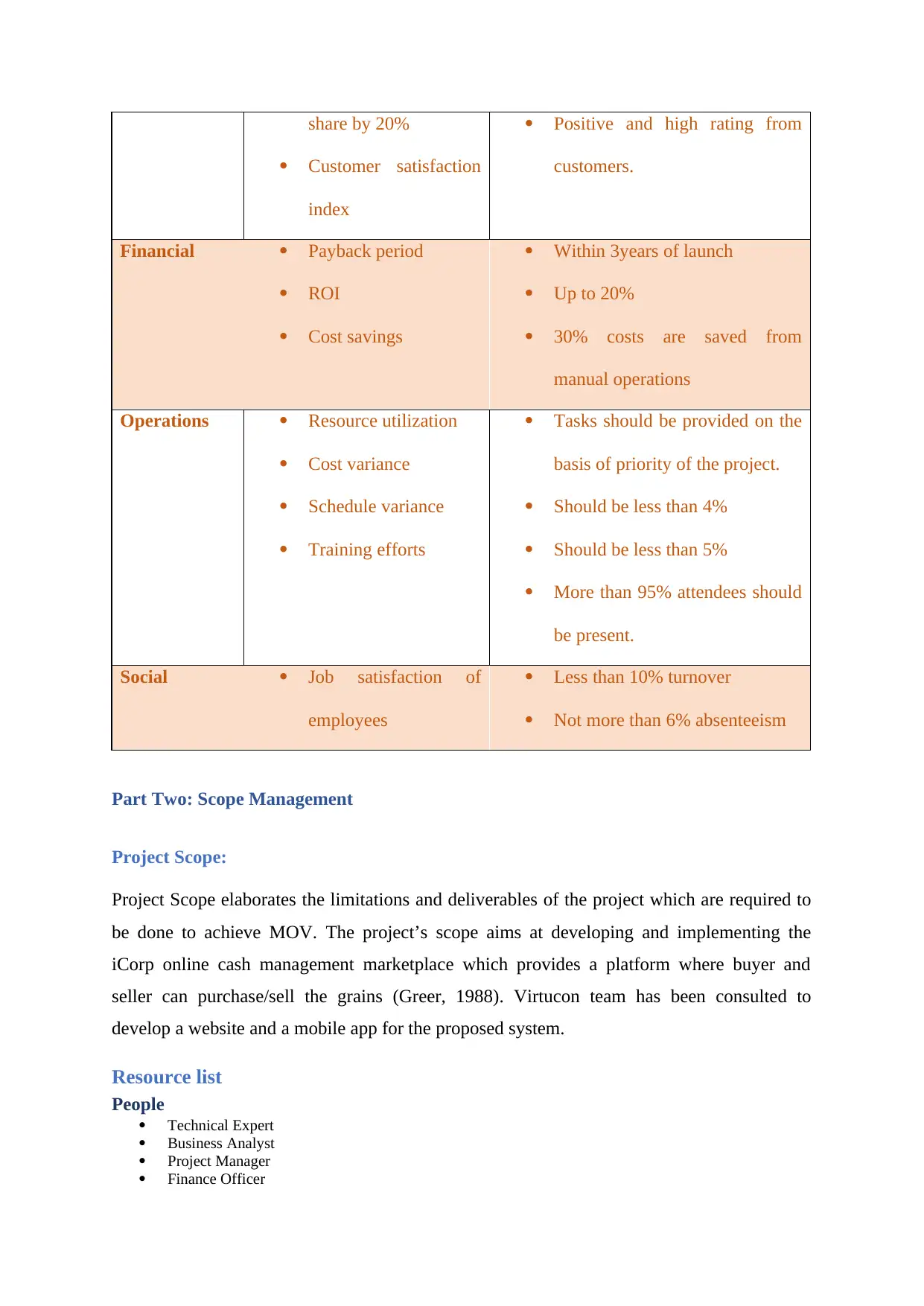
share by 20%
Customer satisfaction
index
Positive and high rating from
customers.
Financial Payback period
ROI
Cost savings
Within 3years of launch
Up to 20%
30% costs are saved from
manual operations
Operations Resource utilization
Cost variance
Schedule variance
Training efforts
Tasks should be provided on the
basis of priority of the project.
Should be less than 4%
Should be less than 5%
More than 95% attendees should
be present.
Social Job satisfaction of
employees
Less than 10% turnover
Not more than 6% absenteeism
Part Two: Scope Management
Project Scope:
Project Scope elaborates the limitations and deliverables of the project which are required to
be done to achieve MOV. The project’s scope aims at developing and implementing the
iCorp online cash management marketplace which provides a platform where buyer and
seller can purchase/sell the grains (Greer, 1988). Virtucon team has been consulted to
develop a website and a mobile app for the proposed system.
Resource list
People
Technical Expert
Business Analyst
Project Manager
Finance Officer
Customer satisfaction
index
Positive and high rating from
customers.
Financial Payback period
ROI
Cost savings
Within 3years of launch
Up to 20%
30% costs are saved from
manual operations
Operations Resource utilization
Cost variance
Schedule variance
Training efforts
Tasks should be provided on the
basis of priority of the project.
Should be less than 4%
Should be less than 5%
More than 95% attendees should
be present.
Social Job satisfaction of
employees
Less than 10% turnover
Not more than 6% absenteeism
Part Two: Scope Management
Project Scope:
Project Scope elaborates the limitations and deliverables of the project which are required to
be done to achieve MOV. The project’s scope aims at developing and implementing the
iCorp online cash management marketplace which provides a platform where buyer and
seller can purchase/sell the grains (Greer, 1988). Virtucon team has been consulted to
develop a website and a mobile app for the proposed system.
Resource list
People
Technical Expert
Business Analyst
Project Manager
Finance Officer
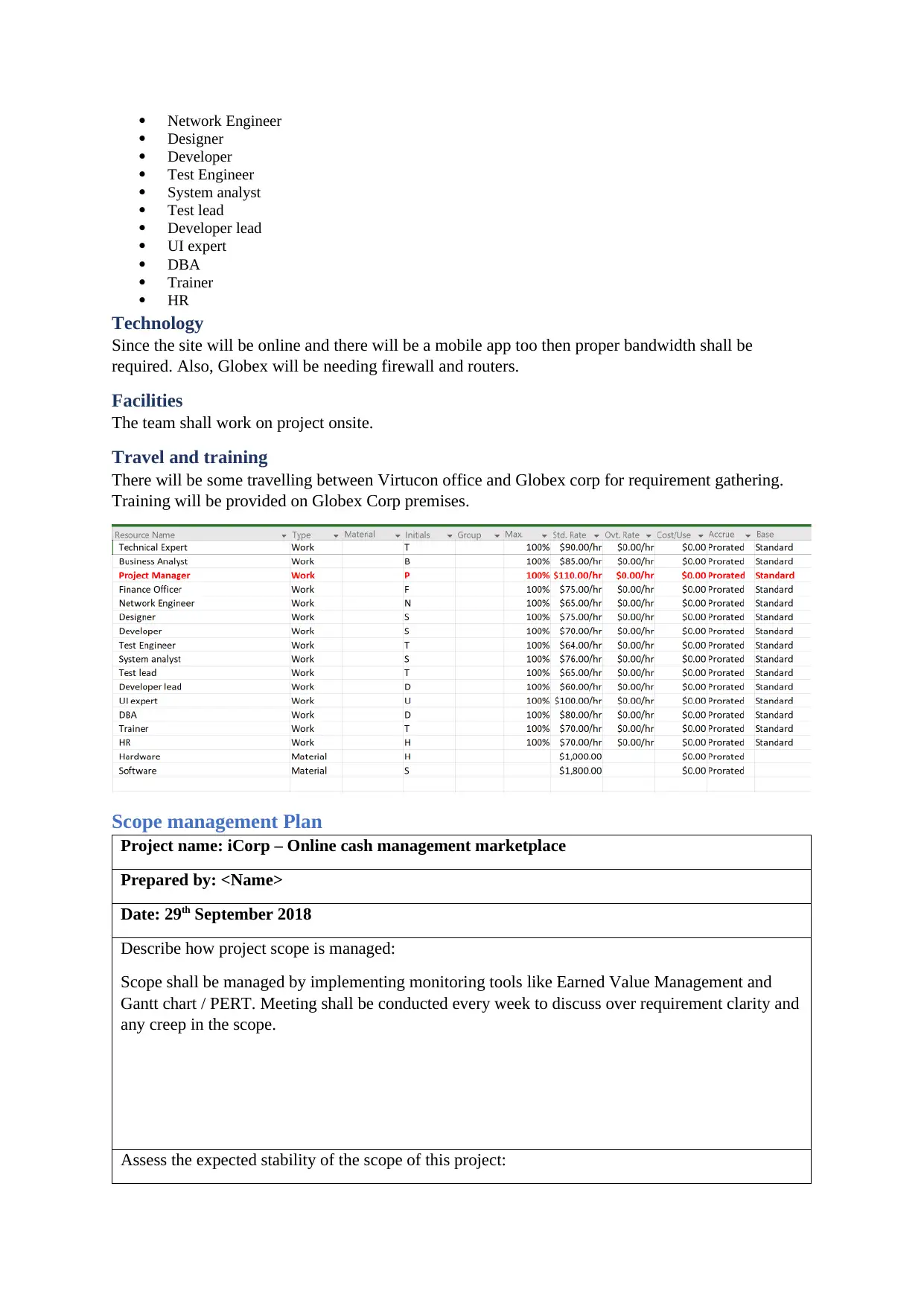
Network Engineer
Designer
Developer
Test Engineer
System analyst
Test lead
Developer lead
UI expert
DBA
Trainer
HR
Technology
Since the site will be online and there will be a mobile app too then proper bandwidth shall be
required. Also, Globex will be needing firewall and routers.
Facilities
The team shall work on project onsite.
Travel and training
There will be some travelling between Virtucon office and Globex corp for requirement gathering.
Training will be provided on Globex Corp premises.
Scope management Plan
Project name: iCorp – Online cash management marketplace
Prepared by: <Name>
Date: 29th September 2018
Describe how project scope is managed:
Scope shall be managed by implementing monitoring tools like Earned Value Management and
Gantt chart / PERT. Meeting shall be conducted every week to discuss over requirement clarity and
any creep in the scope.
Assess the expected stability of the scope of this project:
Designer
Developer
Test Engineer
System analyst
Test lead
Developer lead
UI expert
DBA
Trainer
HR
Technology
Since the site will be online and there will be a mobile app too then proper bandwidth shall be
required. Also, Globex will be needing firewall and routers.
Facilities
The team shall work on project onsite.
Travel and training
There will be some travelling between Virtucon office and Globex corp for requirement gathering.
Training will be provided on Globex Corp premises.
Scope management Plan
Project name: iCorp – Online cash management marketplace
Prepared by: <Name>
Date: 29th September 2018
Describe how project scope is managed:
Scope shall be managed by implementing monitoring tools like Earned Value Management and
Gantt chart / PERT. Meeting shall be conducted every week to discuss over requirement clarity and
any creep in the scope.
Assess the expected stability of the scope of this project:
⊘ This is a preview!⊘
Do you want full access?
Subscribe today to unlock all pages.

Trusted by 1+ million students worldwide
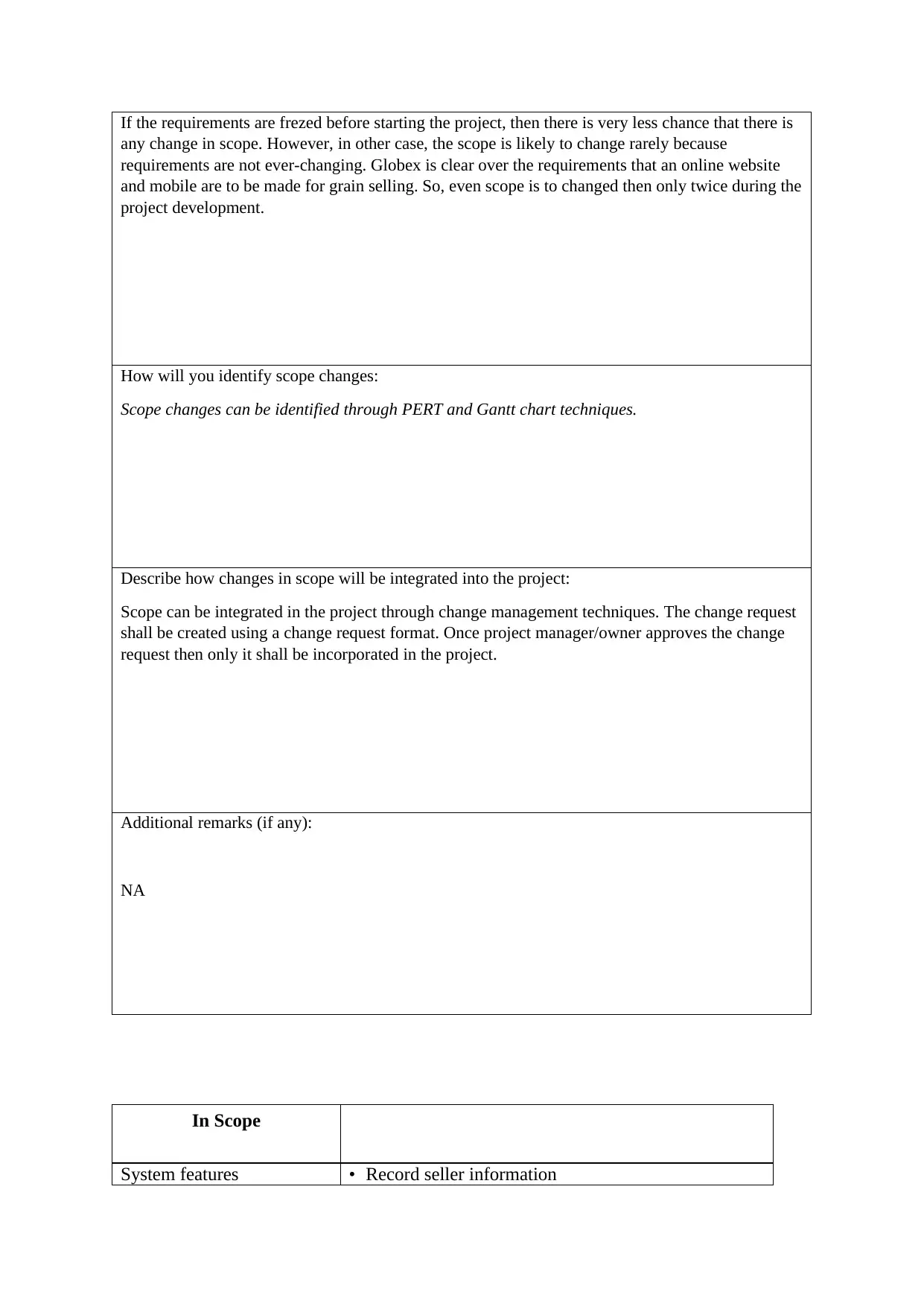
If the requirements are frezed before starting the project, then there is very less chance that there is
any change in scope. However, in other case, the scope is likely to change rarely because
requirements are not ever-changing. Globex is clear over the requirements that an online website
and mobile are to be made for grain selling. So, even scope is to changed then only twice during the
project development.
How will you identify scope changes:
Scope changes can be identified through PERT and Gantt chart techniques.
Describe how changes in scope will be integrated into the project:
Scope can be integrated in the project through change management techniques. The change request
shall be created using a change request format. Once project manager/owner approves the change
request then only it shall be incorporated in the project.
Additional remarks (if any):
NA
In Scope
System features • Record seller information
any change in scope. However, in other case, the scope is likely to change rarely because
requirements are not ever-changing. Globex is clear over the requirements that an online website
and mobile are to be made for grain selling. So, even scope is to changed then only twice during the
project development.
How will you identify scope changes:
Scope changes can be identified through PERT and Gantt chart techniques.
Describe how changes in scope will be integrated into the project:
Scope can be integrated in the project through change management techniques. The change request
shall be created using a change request format. Once project manager/owner approves the change
request then only it shall be incorporated in the project.
Additional remarks (if any):
NA
In Scope
System features • Record seller information
Paraphrase This Document
Need a fresh take? Get an instant paraphrase of this document with our AI Paraphraser
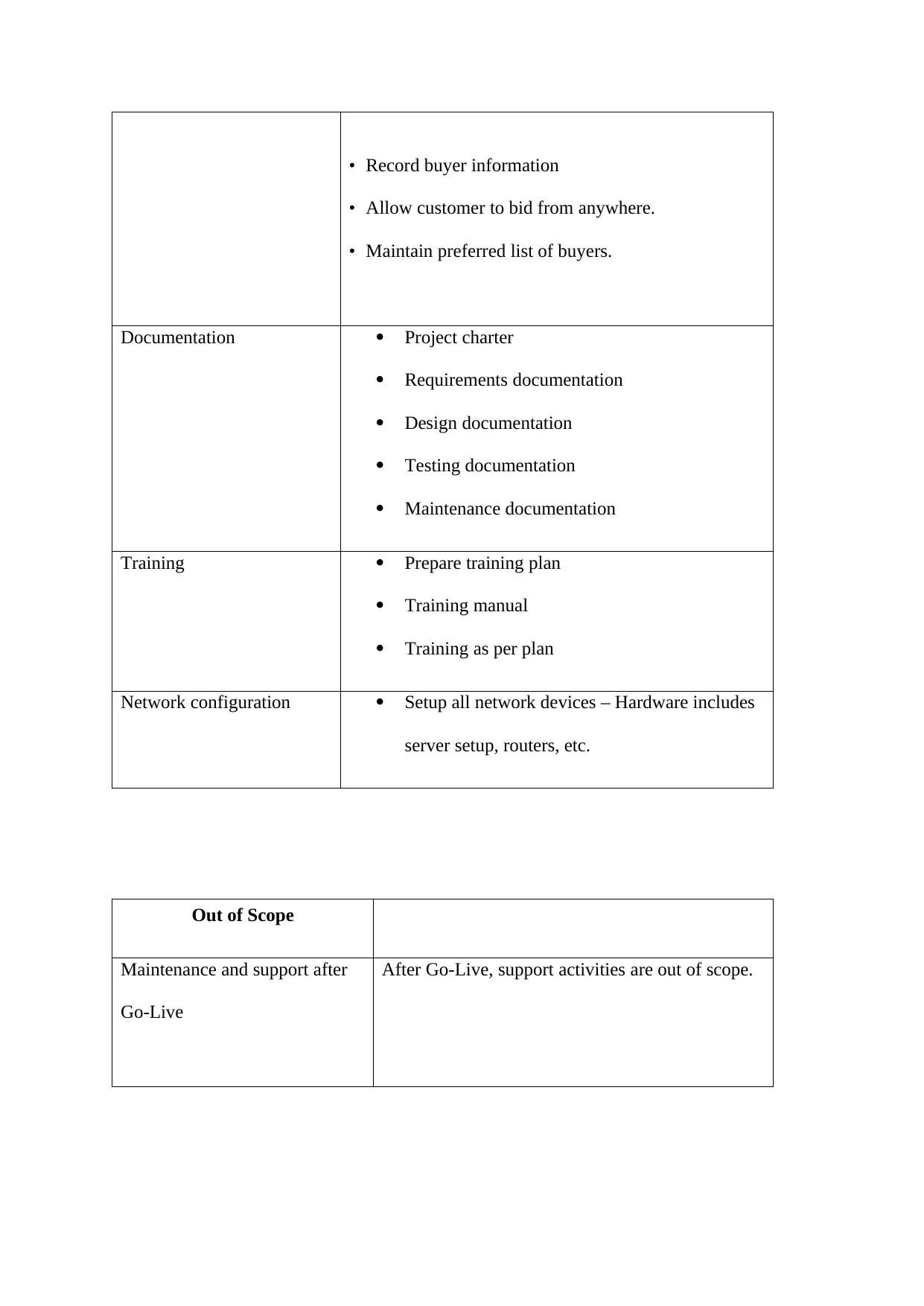
• Record buyer information
• Allow customer to bid from anywhere.
• Maintain preferred list of buyers.
Documentation Project charter
Requirements documentation
Design documentation
Testing documentation
Maintenance documentation
Training Prepare training plan
Training manual
Training as per plan
Network configuration Setup all network devices – Hardware includes
server setup, routers, etc.
Out of Scope
Maintenance and support after
Go-Live
After Go-Live, support activities are out of scope.
• Allow customer to bid from anywhere.
• Maintain preferred list of buyers.
Documentation Project charter
Requirements documentation
Design documentation
Testing documentation
Maintenance documentation
Training Prepare training plan
Training manual
Training as per plan
Network configuration Setup all network devices – Hardware includes
server setup, routers, etc.
Out of Scope
Maintenance and support after
Go-Live
After Go-Live, support activities are out of scope.
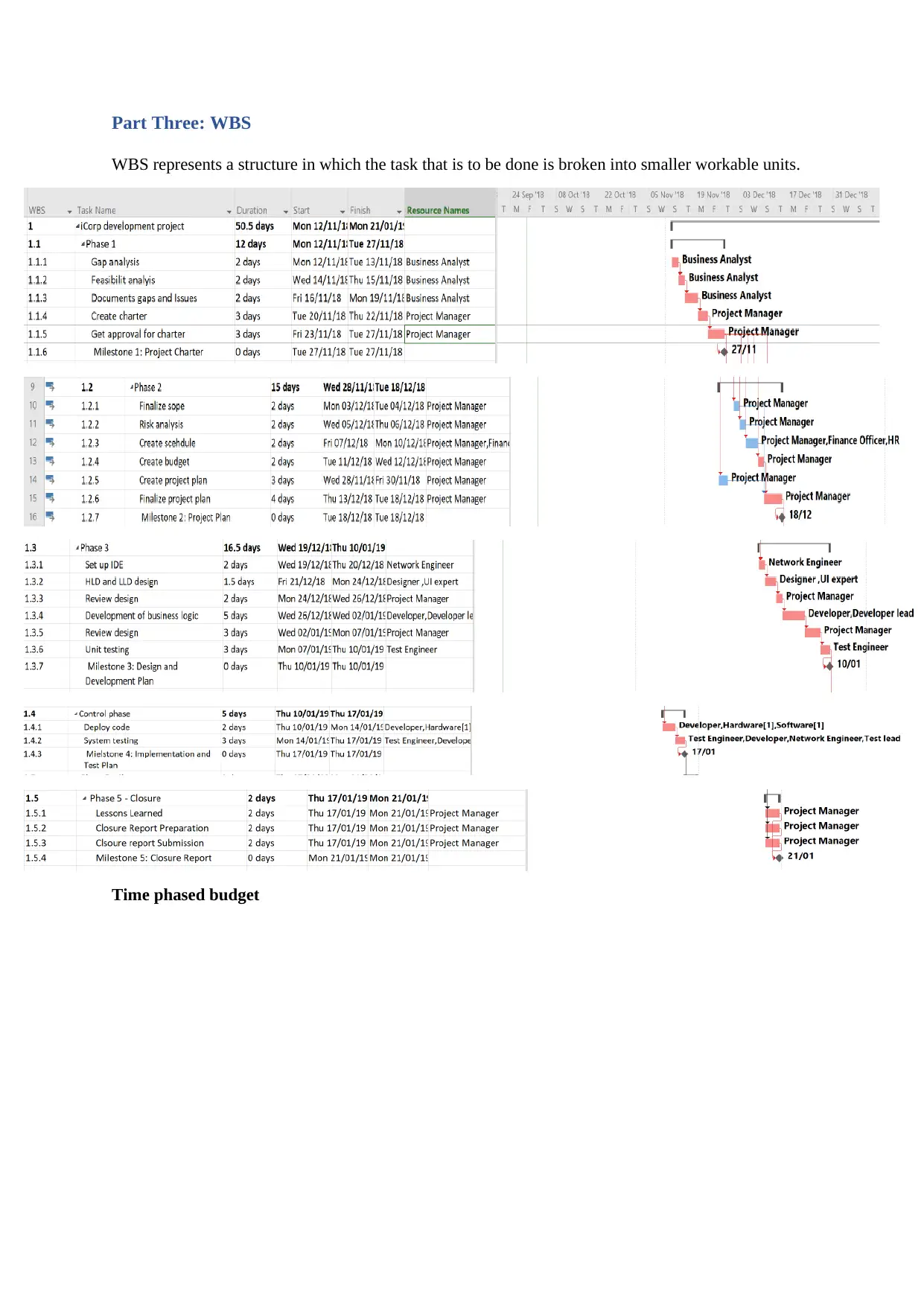
Part Three: WBS
WBS represents a structure in which the task that is to be done is broken into smaller workable units.
Time phased budget
WBS represents a structure in which the task that is to be done is broken into smaller workable units.
Time phased budget
⊘ This is a preview!⊘
Do you want full access?
Subscribe today to unlock all pages.

Trusted by 1+ million students worldwide
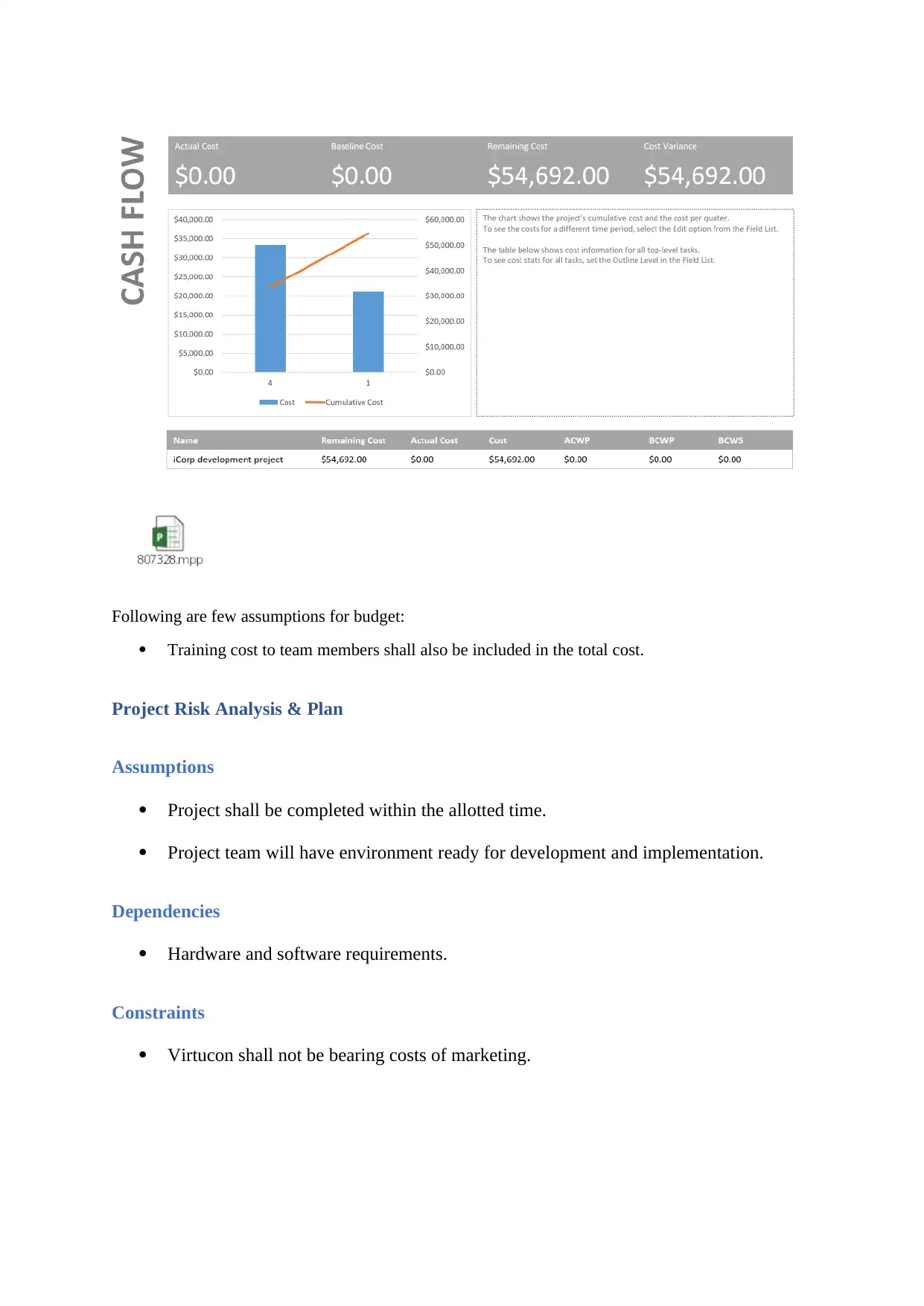
Following are few assumptions for budget:
Training cost to team members shall also be included in the total cost.
Project Risk Analysis & Plan
Assumptions
Project shall be completed within the allotted time.
Project team will have environment ready for development and implementation.
Dependencies
Hardware and software requirements.
Constraints
Virtucon shall not be bearing costs of marketing.
Training cost to team members shall also be included in the total cost.
Project Risk Analysis & Plan
Assumptions
Project shall be completed within the allotted time.
Project team will have environment ready for development and implementation.
Dependencies
Hardware and software requirements.
Constraints
Virtucon shall not be bearing costs of marketing.
Paraphrase This Document
Need a fresh take? Get an instant paraphrase of this document with our AI Paraphraser
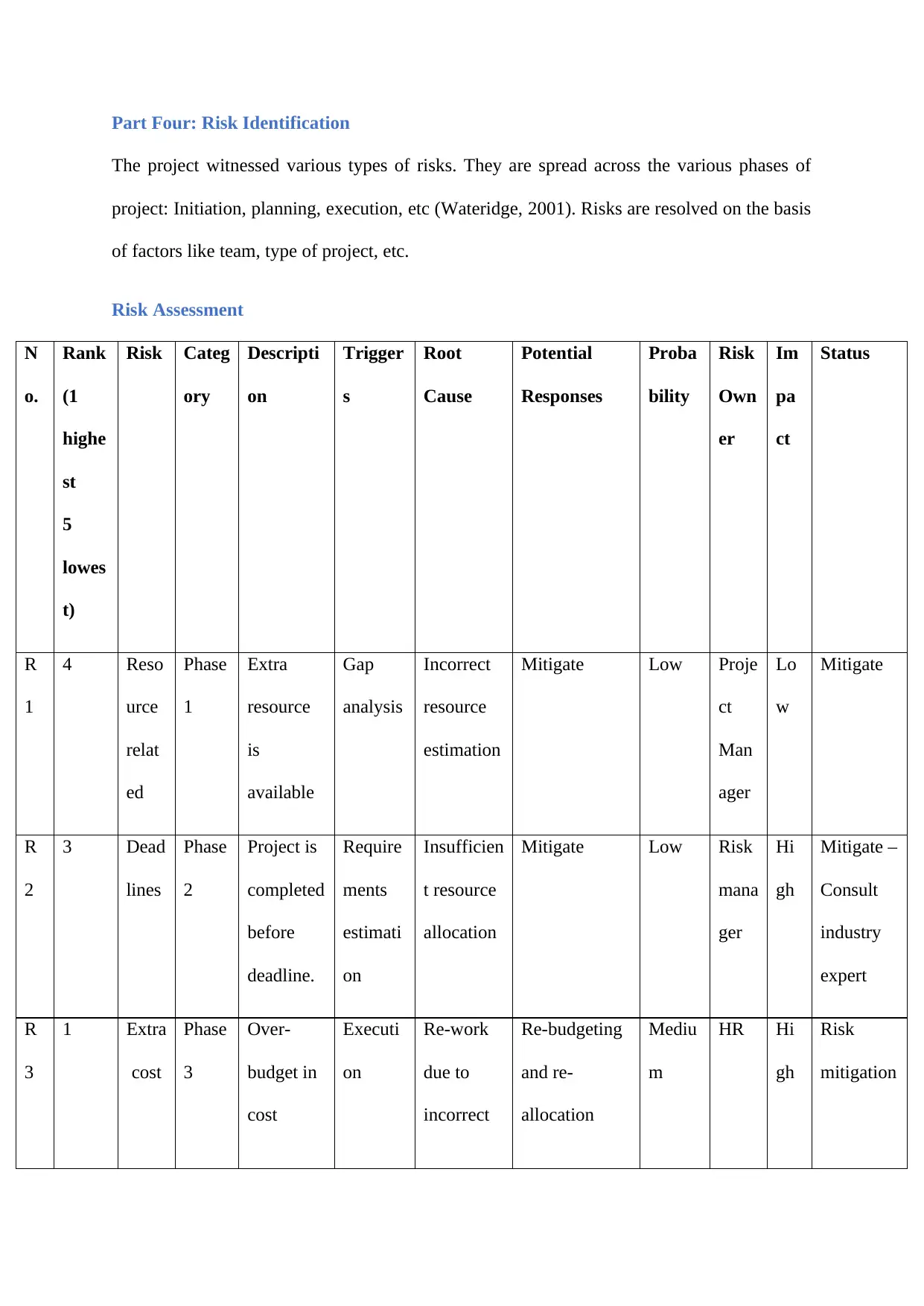
Part Four: Risk Identification
The project witnessed various types of risks. They are spread across the various phases of
project: Initiation, planning, execution, etc (Wateridge, 2001). Risks are resolved on the basis
of factors like team, type of project, etc.
Risk Assessment
N
o.
Rank
(1
highe
st
5
lowes
t)
Risk Categ
ory
Descripti
on
Trigger
s
Root
Cause
Potential
Responses
Proba
bility
Risk
Own
er
Im
pa
ct
Status
R
1
4 Reso
urce
relat
ed
Phase
1
Extra
resource
is
available
Gap
analysis
Incorrect
resource
estimation
Mitigate Low Proje
ct
Man
ager
Lo
w
Mitigate
R
2
3 Dead
lines
Phase
2
Project is
completed
before
deadline.
Require
ments
estimati
on
Insufficien
t resource
allocation
Mitigate Low Risk
mana
ger
Hi
gh
Mitigate –
Consult
industry
expert
R
3
1 Extra
cost
Phase
3
Over-
budget in
cost
Executi
on
Re-work
due to
incorrect
Re-budgeting
and re-
allocation
Mediu
m
HR Hi
gh
Risk
mitigation
The project witnessed various types of risks. They are spread across the various phases of
project: Initiation, planning, execution, etc (Wateridge, 2001). Risks are resolved on the basis
of factors like team, type of project, etc.
Risk Assessment
N
o.
Rank
(1
highe
st
5
lowes
t)
Risk Categ
ory
Descripti
on
Trigger
s
Root
Cause
Potential
Responses
Proba
bility
Risk
Own
er
Im
pa
ct
Status
R
1
4 Reso
urce
relat
ed
Phase
1
Extra
resource
is
available
Gap
analysis
Incorrect
resource
estimation
Mitigate Low Proje
ct
Man
ager
Lo
w
Mitigate
R
2
3 Dead
lines
Phase
2
Project is
completed
before
deadline.
Require
ments
estimati
on
Insufficien
t resource
allocation
Mitigate Low Risk
mana
ger
Hi
gh
Mitigate –
Consult
industry
expert
R
3
1 Extra
cost
Phase
3
Over-
budget in
cost
Executi
on
Re-work
due to
incorrect
Re-budgeting
and re-
allocation
Mediu
m
HR Hi
gh
Risk
mitigation
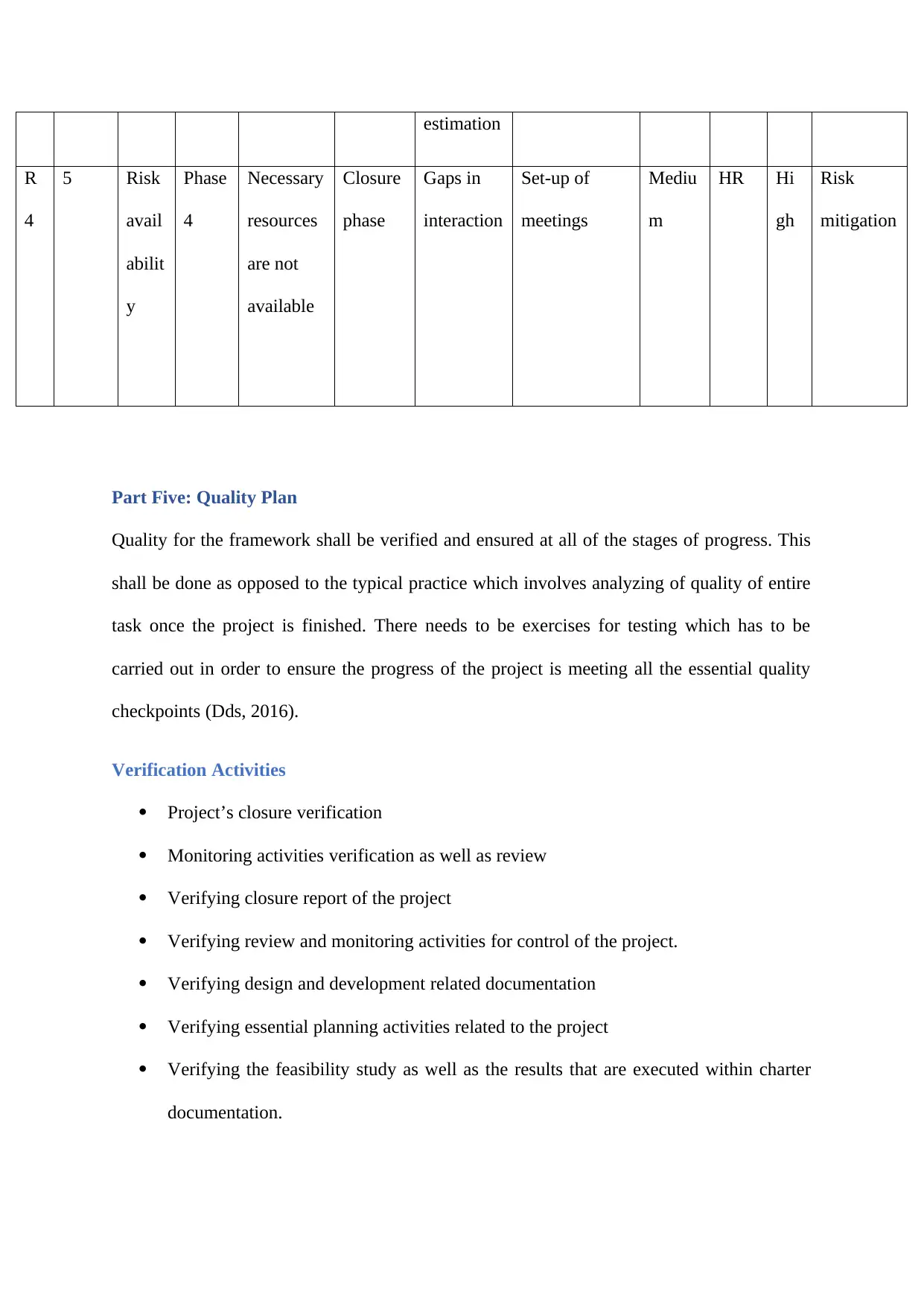
estimation
R
4
5 Risk
avail
abilit
y
Phase
4
Necessary
resources
are not
available
Closure
phase
Gaps in
interaction
Set-up of
meetings
Mediu
m
HR Hi
gh
Risk
mitigation
Part Five: Quality Plan
Quality for the framework shall be verified and ensured at all of the stages of progress. This
shall be done as opposed to the typical practice which involves analyzing of quality of entire
task once the project is finished. There needs to be exercises for testing which has to be
carried out in order to ensure the progress of the project is meeting all the essential quality
checkpoints (Dds, 2016).
Verification Activities
Project’s closure verification
Monitoring activities verification as well as review
Verifying closure report of the project
Verifying review and monitoring activities for control of the project.
Verifying design and development related documentation
Verifying essential planning activities related to the project
Verifying the feasibility study as well as the results that are executed within charter
documentation.
R
4
5 Risk
avail
abilit
y
Phase
4
Necessary
resources
are not
available
Closure
phase
Gaps in
interaction
Set-up of
meetings
Mediu
m
HR Hi
gh
Risk
mitigation
Part Five: Quality Plan
Quality for the framework shall be verified and ensured at all of the stages of progress. This
shall be done as opposed to the typical practice which involves analyzing of quality of entire
task once the project is finished. There needs to be exercises for testing which has to be
carried out in order to ensure the progress of the project is meeting all the essential quality
checkpoints (Dds, 2016).
Verification Activities
Project’s closure verification
Monitoring activities verification as well as review
Verifying closure report of the project
Verifying review and monitoring activities for control of the project.
Verifying design and development related documentation
Verifying essential planning activities related to the project
Verifying the feasibility study as well as the results that are executed within charter
documentation.
⊘ This is a preview!⊘
Do you want full access?
Subscribe today to unlock all pages.

Trusted by 1+ million students worldwide
1 out of 16
Related Documents
Your All-in-One AI-Powered Toolkit for Academic Success.
+13062052269
info@desklib.com
Available 24*7 on WhatsApp / Email
![[object Object]](/_next/static/media/star-bottom.7253800d.svg)
Unlock your academic potential
Copyright © 2020–2025 A2Z Services. All Rights Reserved. Developed and managed by ZUCOL.





